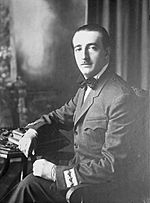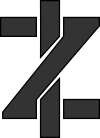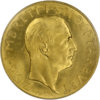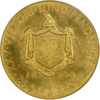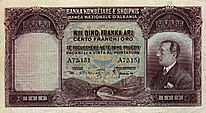Zog I of Albania facts for kids
Quick facts for kids Zog I |
|||||
|---|---|---|---|---|---|
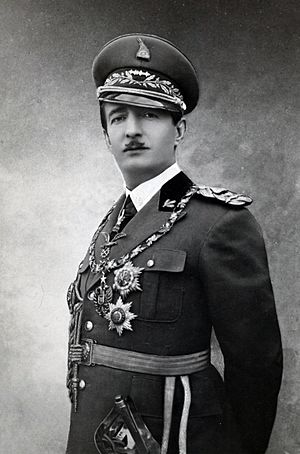 |
|||||
| King of the Albanians | |||||
| Reign | 1 September 1928 – 9 April 1939 (formally deposed 2 January 1946) |
||||
| Predecessor | Himself as President | ||||
| Successor | Victor Emmanuel III | ||||
| President of Albania | |||||
| In office | 31 January 1925 – 1 September 1928 | ||||
| Predecessor | Office established (de facto) Vilhelm I (de jure, as Prince) |
||||
| Successor | Himself as King | ||||
| Prime Minister of Albania | |||||
| First term | 26 December 1922 – 25 February 1924 | ||||
| Predecessor | Xhafer bej Ypi | ||||
| Successor | Shefqet Vërlaci | ||||
| Second term | 6 January 1925 – 1 September 1928 | ||||
| Predecessor | Ilias Vrioni | ||||
| Successor | Koço Kota | ||||
| Born | Ahmed Muhtar bey Zogolli 8 October 1895 Burgajet Castle, Burrel, Ottoman Albania |
||||
| Died | 9 April 1961 (aged 65) Suresnes, Paris, France |
||||
| Burial | Cimetière parisien de Thiais (1961–2012) Mausoleum of the Albanian Royal Family (since 2012) |
||||
| Spouse | Géraldine Apponyi de Nagyappony | ||||
| Issue | Leka, Crown Prince of Albania | ||||
|
|||||
| House | Zogu | ||||
| Father | Xhemal Pasha Zogolli | ||||
| Mother | Sadije Toptani | ||||
| Religion | Sunni Islam | ||||
| Signature | |||||
Zog I (born Ahmed Muhtar Zogolli) was a very important leader in Albania from 1922 to 1939. He changed his name to Ahmet Zogu in 1922. He was Albania's youngest ever prime minister at age 27, serving from 1922 to 1924.
Later, he became president from 1925 to 1928. Finally, he became king from 1928 to 1939. His rule saw many changes in Albania.
Zog came from a powerful family in Ottoman Albania. He was involved in politics from a young age. He even fought in the First World War.
After being a government minister, he was forced to leave Albania in 1924. But he came back later that year with help from Yugoslavia and Russian soldiers. He was then elected prime minister again.
In 1925, Zog was elected president. He gained strong powers and made big changes in the country. He also made an alliance with Benito Mussolini's Italy.
In 1928, Albania became a monarchy, and he became King Zog I. He married Geraldine Apponyi de Nagy-Appony in 1938. Their son, Leka, was born a year later.
During Zog's time as king, Italy gained more and more influence over Albania. By the late 1930s, Albania depended heavily on Italy. In April 1939, Italy invaded Albania.
Mussolini made Albania an Italian protectorate. This forced Zog and his family to leave the country. He lived in England during the Second World War.
After the war, he was not allowed to return to Albania by the new communist government. Zog lived the rest of his life in France. He passed away in April 1961 at 65 years old.
His remains were first buried near Paris. In 2012, they were moved to the royal mausoleum in Tirana, Albania.
Contents
Early Life & Political Beginnings
Zog was born as Ahmet Muhtar Zogolli in Burgajet Castle. This was near Burrel in northern Albania in 1895. He was the third son of Xhemal Pasha Zogolli. His mother was Sadije Toptani.
His family were landowners with power over the Mati region. His mother's family claimed to be related to Skanderbeg. Skanderbeg was a famous Albanian hero from the 15th century.
Zog went to school at Galatasaray High School in Beyoğlu. This area was part of the Ottoman Empire's capital. When his father died in 1911, Zogolli became the governor of Mat. He was chosen over his older half-brother.
In 1912, he helped with the Albanian Declaration of Independence. He represented the Mat District. During the First World War, Zogolli joined the side of Austria-Hungary.
He was held in Vienna in 1917 and 1918. He was also in Rome in 1918 and 1919. He returned to Albania in 1919. While in Vienna, he learned to like the Western European way of life.
When he came back, Zogolli became involved in Albania's new government. Many southern landowners supported him. These were called beys.
In the early 1920s, Zogolli held several important jobs. He was Governor of Shkodër and Minister of the Interior. He also led the Albanian military. His main rivals were Luigj Gurakuqi and Fan S. Noli.
In 1922, Zogolli officially changed his last name to Zogu. This name sounded more Albanian. In 1923, he was shot and wounded in the Parliament.
A crisis happened in 1924 after one of Zogu's opponents was killed. A revolt forced Zogu and his allies to leave Albania. He returned later that year with help from Yugoslavia and Russian troops. He then became Prime Minister.
Becoming President of Albania
Zogu was officially chosen as the first President of Albania. This happened on January 21, 1925. He took office on February 1 for a seven-year term.
A new constitution gave Zogu many powers. He could appoint all main government officials. He also chose one-third of the lower house of parliament. This made him almost like a dictator.
Zogu's government followed European ideas. But much of Albania still had old social structures. Many villages were like serf plantations run by the Beys. In 1925, Zogu gave Sveti Naum to Yugoslavia. In return, Albania received other areas.
Zogu made several big changes. His main helper was the Kingdom of Italy. Italy lent money to his government. In exchange, Italy gained more say in Albania's money matters.
For the first time since Skanderbeg, Albania started to become a true nation. It was no longer just small local areas. Zogu's rule had some problems with leaders from Kosovo.
However, Zogu's Albania was a police state. People had very few freedoms. The news was strictly controlled. Political opponents were often put in prison or killed. He held almost all the power in the country.
Zog Becomes King
On September 1, 1928, Albania became a kingdom. President Zogu became Zog I, King of the Albanians. He used his last name, Zog, as his royal name. This was because his first name, Ahmet, might have made him seem less European.
On the same day, he was also made Field Marshal of the Royal Albanian Army. He created a constitutional monarchy. This was similar to the government in Italy at the time.
He also set up a strong police force. He introduced the Zogist salute, which is a flat hand over the heart. Zog collected gold coins and jewels. These were used to support Albania's first paper money.
Zog's mother, Sadije, was named Queen Mother of Albania. Zog also gave his brother and sisters royal titles. One of his sisters, Senije, married a Turkish prince.
Zog's constitution said that no royal family member could be Prime Minister. It also had rules for what would happen if the royal family ended. The constitution also said Albania's throne could not join with another country's.
King Zog took an oath before Parliament. He swore on both the Bible and the Qur'an. This was to try and unite the country. In 1929, King Zog ended Islamic law in Albania. He adopted a new civil code based on Switzerland's.
This was a big step towards modernizing the country. But it came at a cost. Even though he was a constitutional monarch, Zog kept the strong powers he had as president. So, Albania remained a military dictatorship.
In 1938, Zog allowed Jewish refugees to enter Albania. They were fleeing persecution in Nazi Germany.
Life as King
King Zog came from a noble family. But other European monarchs often ignored him. This was because he declared himself king and was not related to other European royal families.
However, he had good connections with Muslim royal families in the Arab world. This included Egypt, whose ruling family had Albanian roots. As King, he received honors from many countries.
Zog had been engaged before he became king. But he broke off the engagement. In Albania, there was a tradition of blood vengeance. So, the man he broke off the engagement with had the right to try and kill Zog.
Because of this, the king often had many guards around him. He also avoided public appearances. He feared being poisoned. So, his mother oversaw the royal kitchen.
In April 1938, Zog married Countess Geraldine Apponyi de Nagy-Appony. She was a Roman Catholic noblewoman. She was half-Hungarian and half-American. Their wedding was broadcast on Radio Tirana.
Their only child, Crown Prince Leka, was born in Albania on April 5, 1939.
Relations with Italy
The fascist government of Benito Mussolini's Italy supported Zog from the start of his presidency. This support led to Italy having more influence in Albania. The Italians pushed Zog not to renew a treaty from 1926.
Zog still kept British officers in his police force. This was to balance out the Italian influence. During the Great Depression in the early 1930s, Zog's government relied almost completely on Mussolini.
Albania's national bank was even located in Rome. Grain had to be brought in from other countries. Many Albanians moved away. Italians were allowed to live in Albania.
In 1932 and 1933, Albania could not pay back its loans from Italy. Italy used this as an excuse to gain more control. They demanded that Italians lead Albania's police. They also wanted a customs union with Italy.
Italy also wanted control of Albania's sugar, telegraph, and electricity. Finally, Italy demanded that the Italian language be taught in all Albanian schools. Zog quickly refused this demand.
To resist Italy, he cut the national budget by 30 percent. He also sent away all Italian military advisors. He took control of Italian-run Catholic schools in northern Albania. This was to reduce Italian influence.
In 1934, he tried to make ties with France, Germany, and other Balkan states. But he was not successful. Albania then moved back closer to Italy.
Two days after his son was born, on April 7, 1939, Italy invaded Albania. There was not much resistance. The Albanian army was not well-equipped. It was mostly controlled by Italian advisors.
The Italian army was too strong. But some police and people did resist. The Royal Family realized they were in danger. They fled into exile. They took a lot of gold from the National Bank with them.
The family had expected an Italian invasion. So, they had started gathering gold beforehand. Mussolini declared Albania a protectorate under Italy's King Victor Emmanuel III.
Some Albanians kept fighting. But many people welcomed the Italians, according to one report.
Life in Exile and Death
The Royal Family first fled to Greece. Zog said that Hitler and Mussolini were crazy. He said they faced "two fools who sleep" – Chamberlain and Daladier. Zog declared, "We prefer to die... to show our independence is not for sale."
But the world knew Zog had taken most of Albania's treasury gold. So, they were not very impressed. After a short time in Greece, Zog's group went to Istanbul in Turkey. Then they fled through Romania, Poland, Latvia, Sweden, Norway, Belgium to Paris, France.
Zog and his family lived in France for a while. They fled again when the Germans invaded. Their escape from France was helped by a Turkish prince.
The Royal Family then settled in England. Their first home was at The Ritz in London. In 1941, they lived briefly in a house in Sunninghill. Later in 1941, they moved to Parmoor House in Buckinghamshire.
In 1946, Zog and most of his family left England. They went to live in Egypt at the request of King Farouk. In 1951, Zog bought a large estate in New York. But he never lived there.
The estate quickly fell apart, and Zog sold it in 1955. King Farouk was overthrown in 1952. So, Zog's family left Egypt for France in 1955.
He made his final home in France. He died at the Foch Hospital in Suresnes on April 9, 1961. He was 65 years old. Zog was known for smoking a lot of cigarettes. He had been very ill for some time.
He was survived by his wife and son. He was first buried near Paris. When he died, his son Leka was declared King Leka of the Albanians by Albanians living in exile.
His wife, Geraldine, died in 2002 at age 87 in Albania. Albania's communist government ended the monarchy in 1946. But the Royal Family in exile still said Leka Zogu was Albania's rightful ruler until his death in 2011.
Political Legacy
During World War II, three main groups fought in Albania. These were the nationalists, the royalists, and the communists. Some Albanians chose to work with the Germans.
The communist fighters refused to work with the other groups. They eventually took control of the country. They defeated the Nazis and had full control of Albania by November 1944.
Zog tried to get his throne back after the war. But the new Communist government took power. One of their first actions was to ban Zog from ever returning to Albania. They officially removed him from power in 1946.
In 1952, his representatives met with the Yugoslavian government. They discussed possible cooperation. Some groups loyal to Zog tried to enter Albania. They were supported by British and American intelligence agencies. But most were caught because of a spy.
In 1997, a vote was held in Albania. This was seven years after communist rule ended. The vote was to decide if the monarchy should return. Zog's son, Leka Zogu, was the person who would become king.
The official results said that about two-thirds of voters wanted to keep the republic. Leka believed the results were fake. He tried to start an armed uprising. He was not successful and had to leave Albania.
He later returned and lived in Tirana until his death in 2011. A main street in Tirana was later renamed "Boulevard Zog I" by the Albanian government.
Repatriation to Albania
In October 2012, the Albanian government decided to bring Zog's remains back from France. He had died there in 1961. Zog's body was dug up from the Thiais Cemetery in Paris on November 15, 2012.
The French President provided a special guard of honor. Zog's remains were returned in a state ceremony on November 17, 2012. This was during celebrations for Albania's independence centennial.
The bodies of the king and his family members now rest in the rebuilt royal mausoleum in Tirana. The ceremony was attended by the Albanian government. This included the President and Prime Minister. Important people from the Romanian, Montenegrin, Russian, and Albanian royal families were also there.
Honours and Awards
In Albania:
 Sovereign Head of the Order of Fidelity
Sovereign Head of the Order of Fidelity Sovereign Head of the Order of Skanderbeg
Sovereign Head of the Order of Skanderbeg Sovereign Head of the Order of Bravery & Military Merit: First Class or Hero, breast star
Sovereign Head of the Order of Bravery & Military Merit: First Class or Hero, breast star National Flag Order (given after his death)
National Flag Order (given after his death)
From other countries:
 Commander of the Order of Franz Joseph with Swords (Austrian Empire, January 1917)
Commander of the Order of Franz Joseph with Swords (Austrian Empire, January 1917) Grand Cross of the Legion of Honour (France, 1926)
Grand Cross of the Legion of Honour (France, 1926) Knight of the Order of the Most Holy Annunciation (Kingdom of Italy, 1928)
Knight of the Order of the Most Holy Annunciation (Kingdom of Italy, 1928) Knight Grand Cross of the Order of Saints Maurice and Lazarus (Kingdom of Italy, 1928)
Knight Grand Cross of the Order of Saints Maurice and Lazarus (Kingdom of Italy, 1928) Knight Grand Cross of the Order of the Crown of Italy (Kingdom of Italy, 1928)
Knight Grand Cross of the Order of the Crown of Italy (Kingdom of Italy, 1928) Order of the Gold Lion of the House of Nassau (Netherlands)
Order of the Gold Lion of the House of Nassau (Netherlands) Collar of the Order of Muhammad Ali (Kingdom of Egypt)
Collar of the Order of Muhammad Ali (Kingdom of Egypt) Grand Collar of the Order of Carol I (Kingdom of Romania, 1928)
Grand Collar of the Order of Carol I (Kingdom of Romania, 1928) Grand Cross of the Order of the Karađorđe's Star (Kingdom of Yugoslavia)
Grand Cross of the Order of the Karađorđe's Star (Kingdom of Yugoslavia) Grand Cross of the Order of the Redeemer (Kingdom of Greece)
Grand Cross of the Order of the Redeemer (Kingdom of Greece) Grand Cordon of the Order of Leopold (Belgium, 1929)
Grand Cordon of the Order of Leopold (Belgium, 1929) Grand Cross of the Order of Civil Merit of Bulgaria (Kingdom of Bulgaria)
Grand Cross of the Order of Civil Merit of Bulgaria (Kingdom of Bulgaria) Order of the White Eagle (Poland)
Order of the White Eagle (Poland) Collar First Class of the Order of the White Lion (Czechoslovakia)
Collar First Class of the Order of the White Lion (Czechoslovakia) Grand Star of the Decoration of Honour for Services to the Republic of Austria (Austria)
Grand Star of the Decoration of Honour for Services to the Republic of Austria (Austria) Knight of the Order of the Gold Lion of the House of Nassau (Luxembourg)
Knight of the Order of the Gold Lion of the House of Nassau (Luxembourg) Grand Cross of the Order of Saint Stephen of Hungary (Hungary, 1938)
Grand Cross of the Order of Saint Stephen of Hungary (Hungary, 1938)
See also
 In Spanish: Zog I de Albania para niños
In Spanish: Zog I de Albania para niños
- House of Zogu
- Royal Albanian Army
- Zogist salute
- Legality Movement
- History of Albania
- Self-proclaimed monarchy
- European interwar dictatorships



